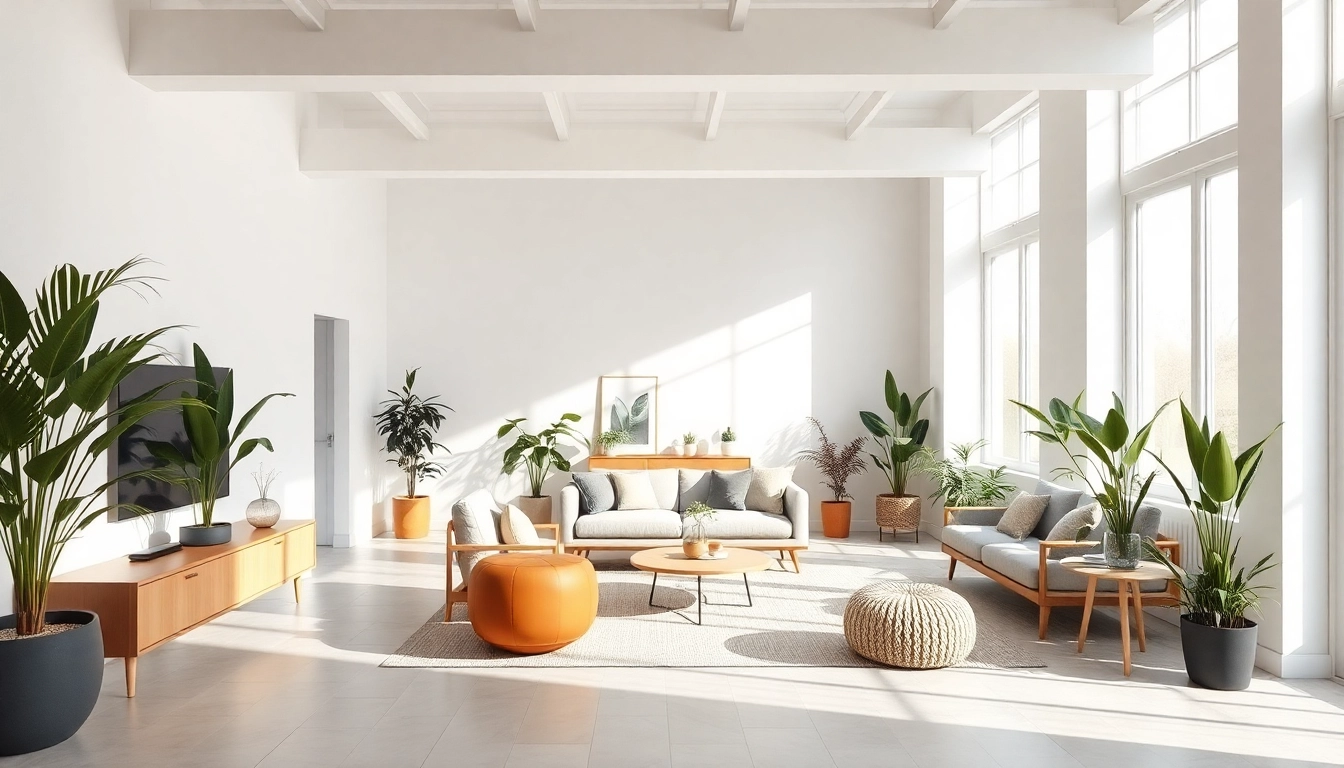Understanding Your Entire Interior Space
The process of transforming your home begins with a comprehensive understanding of the entire interior space you have. This initial step is critical as the layout, design elements, and overall ambiance of your home reflect your lifestyle and personal preferences. In this section, we will delve into key concepts including floor plans, essential design focus areas, and the impact of natural light within your home, paving the way for a harmonious interior makeover.
Mapping Out Floor Plans and Layouts
Creating an effective floor plan is the backbone of any successful interior design project. It requires a thorough examination of your existing layout and understanding how spaces can be optimized. Begin by sketching your floor plan, either through software tools or on paper. Identify rooms and their dimensions, paying attention to traffic flow and how daily activities occur.
You can classify spaces into public, private, and service areas. Public spaces like the living room and kitchen should be inviting and functional, while private spaces such as bedrooms require a more relaxed atmosphere. Moreover, ensure that connecting areas like hallways allow for smooth transitions between spaces. This will make the entire interior cohesive and functional.
Identifying Key Areas for Design Focus
Once the floor layout is finalized, identify areas that need the most attention for design focus. Often, living rooms, dining areas, and kitchens are where families gather and socialize, making them ideal spots for improvements. Think about what modifications will elevate these areas. Consider upgrading lighting fixtures, changing the furniture arrangement, or introducing statement decor pieces. Focus on elements that can captivate and create a lasting impression.
Integrating Natural Light and Ambiance
Natural light plays a significant role in setting the mood and energy of your home. Analyze how light enters your space throughout the day. Rooms that face south generally receive the most sunlight, while those facing north may be cooler and more subdued. Use this knowledge to inform your design decisions—light curtains can soften harsh daylight, while darker fabrics can add warmth to naturally dim areas.
Additionally, consider incorporating mirrors to amplify natural light and create an illusion of more space. Strategically placing mirrors across windows can transform a dimly lit room into a bright and inviting one. Combining these techniques can significantly enhance the overall ambiance of your interior.
Choosing the Right Color Schemes for Your Entire Interior
The color palette you choose for your home is one of the most powerful tools you have when designing your interior. It can completely change the atmosphere of your space. This section will guide you in grasping the nuances of color psychology, exploring trends for the upcoming year, and ensuring color coordination throughout different rooms to create a unified look.
Impact of Color Psychology on Home Feel
Color psychology is a significant aspect of interior design. Different colors can evoke different feelings and moods. For instance, blues and greens are often associated with tranquility and nature, ideal for bedrooms or meditation spaces. On the contrary, warm colors like red and orange create energizing, vibrant environments, making them suitable for dining rooms or creative spaces.
Consider using neutral colors as a base; they can complement more vibrant shades effectively. They provide a balanced backdrop and allow for the flexibility of changing accessories as trends evolve without requiring a complete redesign. It’s important to take the time to experiment and visualize how color changes can affect the mood of a space before committing.
Top Color Trends for 2024
As each year brings new trends in the design world, staying updated helps you make informed decisions. For 2024, expect to see deep earth tones gaining popularity, emphasizing connection to nature and comfort. Shades like terracotta, sage green, and soft browns will dominate interiors, creating warm and inviting spaces.
Accent walls remain a great way to introduce these colors without overwhelming the entire room, while combining them with lighter shades can maintain balance and expand the space visually. Pairing these colors with various textures can amplify their appeal and richness, making your interior feel layered and thoughtfully designed.
Coordinating Colors throughout Different Rooms
Achieving harmony across your interior requires you to use coordinated colors throughout different rooms. Choose a primary color theme and carry it across spaces for continuity. This does not mean adopting the same colors in every room; instead, explore analogous or complementary colors that connect well together.
Transitional spaces, such as hallways, can serve as a bridge between differently colored rooms. Using a neutral backdrop here can help ensure a smooth transition while showcasing your personal style in adjacent rooms. Remember to walk through your home and observe how colors interact, ensuring a cohesive flow.
Furniture Selection for an Entire Interior Makeover
Furniture is one of the most tangible aspects of your interior that influences both form and function. The selection of furniture should reflect not only your style preferences but also accommodate the various activities that take place within your spaces. This section will discuss how to balance aesthetics and utility in your choices, find space-saving solutions, and identify must-have pieces for today’s modern living.
Balancing Functionality and Aesthetics
When curating your furniture pieces, remember that functionality should not come at the expense of aesthetics. Consider multi-functional furniture that serves multiple roles; for instance, a coffee table that doubles as storage can reduce clutter while providing style. Choose pieces that enhance the room’s dominant style—modern, traditional, or eclectic—without sacrificing comfort and usability.
When selecting upholstery, consider fabrics that can withstand daily use, especially in family spaces. High-performance fabrics may offer the visual appeal of luxurious textures while also being durable and easy to maintain. Hardware elements, such as legs and knobs, can also reflect your aesthetic while ensuring each piece is functional and aligned with your overall design.
Space-Saving Solutions for Smaller Homes
In smaller homes, maximizing space is essential for a comfortable living experience. Invest in furniture designed for compact living, such as foldable desks, expandable dining tables, and nesting tables. Modular furniture pieces can adapt to your needs—offering versatility while maintaining style.
Using vertical space is another effective strategy. Tall bookshelves or wall-mounted storage can help free up floor space while adding visual interest. Look for furniture pieces that incorporate hidden storage underneath, such as beds with drawers, to keep clutter out of sight while optimizing your space.
Must-Have Furniture Pieces for Modern Living
As you curate your interior, focus on selecting key furniture pieces that ground your design. A statement sofa in a bold color can become a focal point, while side chairs or ottomans can supplement seating effectively. An eye-catching dining table can serve as both a functional and aesthetic centerpiece for communal gatherings.
Moreover, don’t underestimate the importance of accent tables—small tables placed strategically can provide functional space for drinks or lamps, enhancing functionality. The incorporation of unique storage solutions like a stylish trunk or chic console table can further elevate your interior’s utility and appeal.
Accessorizing Your Entire Interior
Accessories play a pivotal role in personalizing your interior and reflecting your tastes. In this section, we’ll delve into the significance of textures and fabrics, the inclusion of artwork and decorative pieces, and the benefits of incorporating plants to breathe life into your spaces.
Importance of Textures and Fabrics
Texture adds detail and depth to your interior, allowing it to come alive. Mixing various textures through fabrics is an effective way to create a multilayered look. Consider pairing smooth leather sofas with fluffy throw pillows and knits to create a cozy environment. Layering textiles—such as using rugs, curtains, and cushions—can also contribute to a room’s warmth and comfort.
Choosing a variety of fabrics—such as silks versus wools—allows you to create contrast and enhance the visual and tactile experience within your spaces. Cultivating a balance of hard and soft surfaces will ultimately lead to a more inviting and sophisticated atmosphere throughout your entire interior.
Utilizing Artwork and Decorative Pieces
Artwork is an essential accessory that can dramatically influence the character of your home. The choice of art pieces should resonate with your tastes and provide insight into your interests. Whether it’s modern art, landscapes, or family portraits, consider mixing framed art with other decorative elements, like sculptures or books, to create an engaging display.
Creating gallery walls or statement spaces with larger works allows for creative expression. Ensure that your art complements the overall color palette and style of your home; this creates a harmonious visual narrative, giving your audience a sense of the ambiance you wish to convey.
Incorporating Plants for Freshness
Plants add a natural touch, enhancing your home’s aesthetics while improving air quality. They can serve as focal points or subtle accents, depending on their size and placement. From lush indoor trees to small succulents on shelves, there is a wide variety to choose from that can suit any space and design style. Popular indoor plants like snake plants or pothos are not only beautiful but also easy to care for.
Factor in how much natural light the plants will receive—selecting the right type based on light exposure will ensure they thrive. Strategically placing plants in corners, on window sills, or hanging from ceilings can create visually appealing green accents that breathe life into your interior.
Maintaining Cohesion Across Your Entire Interior
Once you’ve curated your space, it’s essential to maintain cohesion across your entire interior. This section will discuss how to link different rooms through consistent design elements, simple maintenance tips for keeping your home fresh, and measuring the impact of your design changes.
Linking Different Rooms through Design Elements
A cohesive design provides a seamless flow between rooms, enhancing the overall aesthetic and functioning of your home. Start by selecting a few key design elements that carry through each space, such as specific colors, patterns, or materials. This unifying approach helps connect disparate areas, tying the home together beautifully.
For example, if you use hardwood flooring throughout the house, it binds the spaces while allowing other functionalities like rugs or carpets to add further depth into each room. Employ similar architectural details like moldings, door hardware, or lighting fixtures to maintain consistency while applying personal touches to each area.
Regular Upkeep and Refresh Ideas
Maintaining your home’s appearance requires consistent upkeep. Regular cleaning and decluttering play crucial roles in preserving your interior’s aesthetic. Schedule seasonal refreshes where you can rotate decorative pieces, add new plants, or update color accents to keep things feeling fresh without a complete overhaul.
Consider repainting or deep-cleaning high-traffic areas periodically, as wear and tear can detract from the overall look. Embrace small updates like swapping out throw pillows or art pieces that add little effort but significant impact. These strategies will keep your home visually appealing and sustain its value over time.
Measuring the Impact of Your Interior Changes
Finally, it’s essential to measure the impact of your design changes. After implementing new furniture, colors, or accessories, take time to assess how these changes influence the atmosphere and practicality of your spaces. Gather feedback from family or friends and observe your everyday interactions with your environment to gain valuable insights.
Utilize metrics such as comfort levels, functionality, and even how often spaces are used to evaluate the success of your interior design. Keeping a visual journal or before-and-after documentation can also serve as a reference for future projects and improvements.



